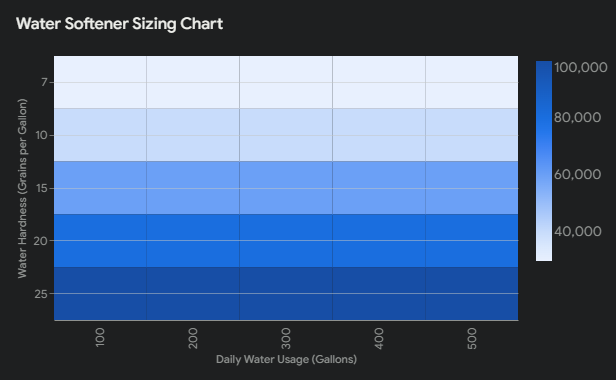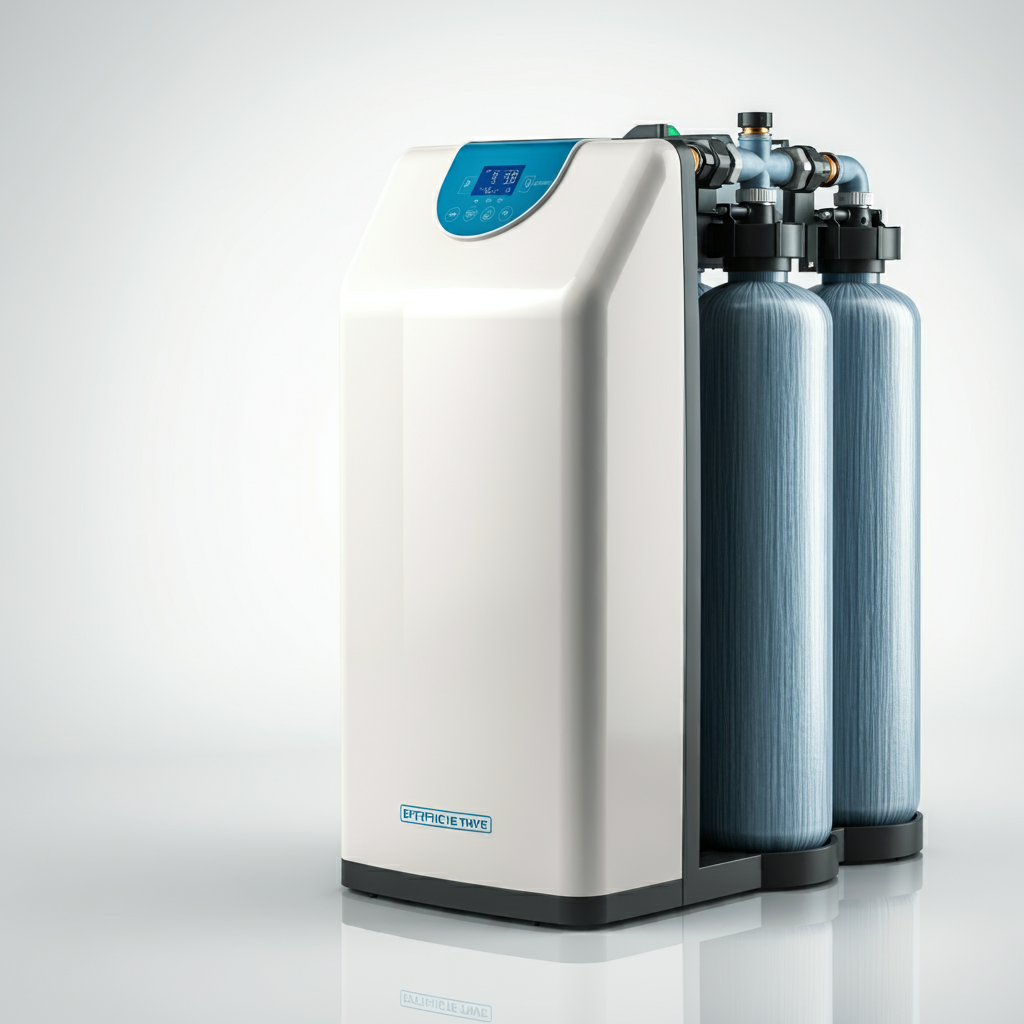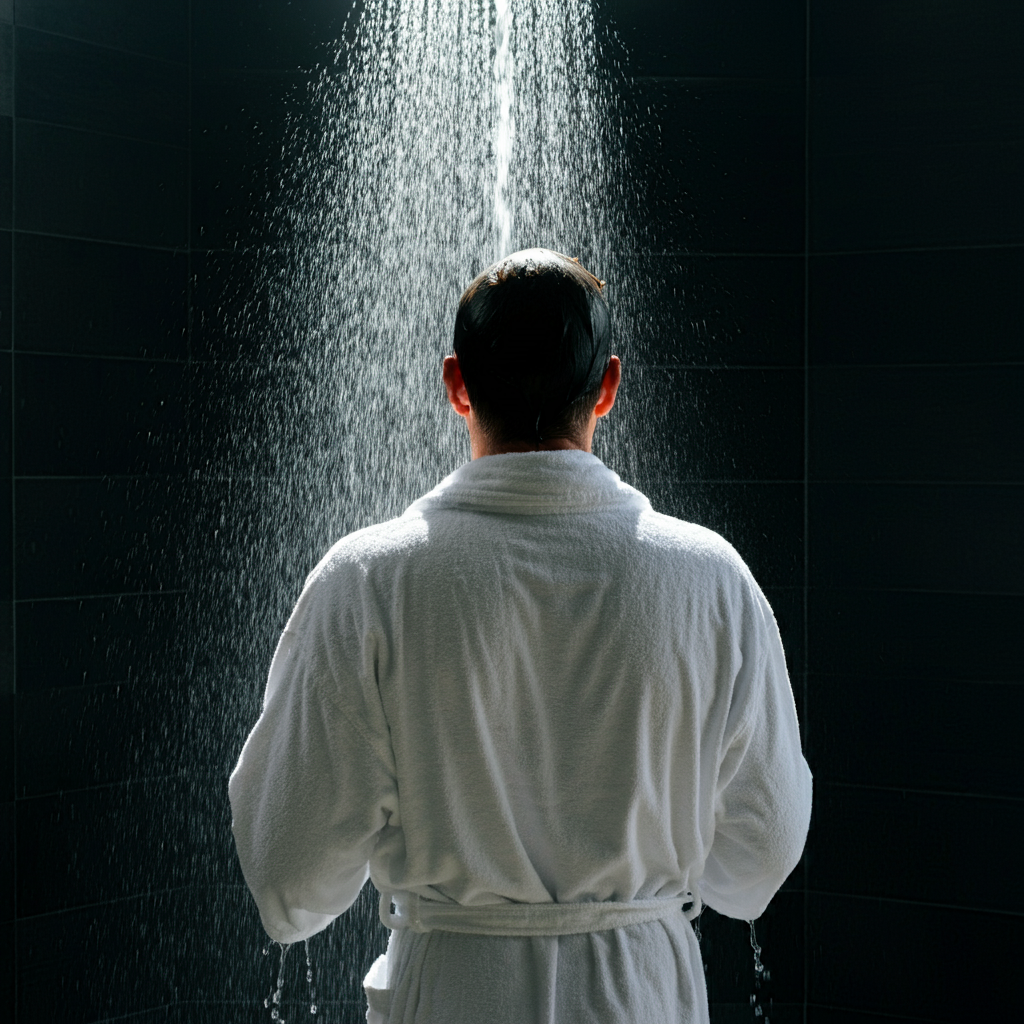The average person in the United States uses approximately 82 gallons of water per day, according to the U.S. Geological Survey (USGS). However, this figure is merely a national average, and individual water consumption can vary significantly based on several factors, including household size, lifestyle habits, and the efficiency of appliances. Understanding your household’s daily water usage is a critical first step in determining the appropriate size of a water softener. A water softener is a device that removes minerals that cause water hardness, such as calcium and magnesium, from your home’s water supply. The size of the water softener you need is directly influenced by the amount of water your household consumes and the hardness of your water, measured in grains per gallon (gpg). Water softeners operate by using a resin bed to attract and trap hardness minerals. Once the resin bed becomes saturated, it needs to regenerate, a process that flushes out the minerals and recharges the resin. If a water softener is too small for a household’s water usage, it will regenerate too frequently, leading to wasted water and salt. Conversely, an oversized water softener is an unnecessary investment, as it will have excess capacity that is never utilized. At WaterSoftenerSizing.com, we specialize in helping homeowners and businesses accurately size their water softeners to ensure optimal performance, efficiency, and cost-effectiveness. We understand that selecting the right size can be a daunting task, but our team of experts is here to guide you through the process, taking into account your specific water usage and hardness levels. Unlike general water filtration systems, which primarily remove sediment and chlorine, water softeners specifically target the minerals responsible for water hardness. This targeted approach not only improves the taste and feel of your water but also extends the lifespan of your appliances and plumbing fixtures by preventing the buildup of scale caused by hard water.
How Much Water Does the Average Person Use Each Day?
As we mentioned, the average American uses about 82 gallons of water per day. This figure, provided by the U.S. Geological Survey (USGS), is a helpful starting point, but it’s important to remember that individual water use can fluctuate significantly. A person living in an arid climate with outdoor watering needs will naturally use more water than someone in a cooler region. Similarly, a household with high-efficiency appliances will generally use less water than one with older, less efficient models. Let’s take a closer look at the breakdown of water usage by activity, based on data from the Water Quality Association (WQA) and the Environmental Protection Agency (EPA):
- Shower: The average shower uses 17.2 gallons of water. However, this can vary depending on the showerhead’s flow rate and the length of the shower. A 10-minute shower with a standard 2.5 gallons per minute (gpm) showerhead will use 25 gallons, while a water-saving 2.0 gpm showerhead used for the same duration would only use 20 gallons.
- Toilet: Flushing accounts for a significant portion of household water use. Older toilets can use 3.5 to 7 gallons per flush, while newer, high-efficiency models use as little as 1.28 gallons per flush. Assuming an average of 5 flushes per day, this translates to 14.1 gallons for a standard toilet and only 6.4 gallons for a high-efficiency model.
- Faucet: Running the faucet for activities like washing hands, brushing teeth, or washing dishes can consume roughly 15.7 gallons per day. This can easily increase if faucets are left running unnecessarily.
- Clothes Washer: The average household does about 8 loads of laundry per week, with each load using around 21.7 gallons of water. High-efficiency washing machines can drastically reduce this number, using as little as 15 gallons per load.
- Leaks: Leaks can be a silent culprit of excessive water usage. The EPA estimates that the average household’s leaks can account for nearly 14 gallons of wasted water per day. Fixing leaks promptly can significantly reduce your water consumption.
While these are the primary water-consuming activities, it’s important to remember that other factors, such as dishwasher usage, outdoor watering, and even the presence of leaks, can also contribute to your overall water consumption. By understanding where your water is going, you can make informed decisions about water conservation and water softener sizing.
How Household Size Impacts Water Usage
The size of your household plays a significant role in determining your overall daily water consumption. Naturally, a larger household with more occupants will use more water than a smaller one. However, individual habits within the household can also cause significant fluctuations in water use.
| Household Size | Average Daily Water Usage (Gallons) |
| 1 person | 50-70 |
| 2 people | 100-140 |
| 3 people | 150-210 |
| 4 people | 200-280 |
These figures are estimates, and actual usage can vary. For example, a family of four with teenagers who take long showers and frequently run the dishwasher might use significantly more than 280 gallons per day. Conversely, a couple who are mindful of their water consumption and use high-efficiency appliances could use less than the estimated range for a two-person household. Understanding your household’s specific water usage patterns is crucial for accurately sizing your water softener. You can track your water usage by checking your water bill or installing a water meter. By monitoring your consumption, you can identify areas where you might be able to conserve water and potentially downsize the softener you need. In addition to household size, factors such as lifestyle and climate can also influence water usage. For instance, individuals living in hot climates might use more water for showering and outdoor watering compared to those in cooler regions. Similarly, those with active lifestyles who frequently shower or do laundry might consume more water than those with more sedentary routines.
How Does Water Hardness Affect Softener Sizing?
Water hardness, a common issue in many households across the United States, is the amount of dissolved calcium and magnesium in your water supply. It’s measured in grains per gallon (gpg) and can vary significantly from region to region. Understanding your water hardness is essential when determining the right size of a water softener for your home. A professional water test is the most reliable way to determine your water’s hardness level. While some general guidelines exist, such as the Water Quality Association’s (WQA) classification of “hard” water as 7 gpg or higher, the only way to get a precise measurement is through testing. Hard water can wreak havoc on your home, causing scale buildup in pipes and appliances, reducing soap lathering ability, and leaving behind unsightly spots on dishes and fixtures. Water softeners address this issue by removing the calcium and magnesium ions through a process called ion exchange, replacing them with sodium or potassium ions. The hardness of your water directly affects the capacity of the water softener you need. A softener’s capacity, typically measured in grains, represents the amount of hardness it can remove before it needs to regenerate. For example, a softener with a 40,000-grain capacity can remove 40,000 grains of hardness minerals before requiring regeneration. If you have very hard water (e.g., 15 gpg) and a high daily water usage (e.g., 300 gallons), your softener will need to remove a large amount of hardness minerals each day. This means you’ll need a softener with a higher capacity to avoid frequent regeneration cycles. On the other hand, if your water is only moderately hard (e.g., 5 gpg) and your water usage is lower, a smaller capacity softener may be sufficient. The frequency of regeneration also plays a role in softener sizing. While a larger softener can remove more hardness before needing to regenerate, it will still require regeneration at some point. If you prefer to regenerate less often, you might opt for a slightly larger softener than the minimum capacity needed for your daily hardness removal.
Calculating the Right Water Softener Size for Your Home
 Determining the ideal water softener size for your home requires a bit of calculation, but don’t worry, we’ll guide you through it. The core principle is simple: the size of your softener should be based on your daily water usage and the hardness of your water. The basic formula for calculating the required softener capacity is: (Daily water usage in gallons) x (Water hardness in gpg) = Daily grain removal needed For example, if your household uses 250 gallons of water per day and your water hardness is 10 gpg, your softener needs to remove 2500 grains of hardness daily (250 gallons x 10 gpg = 2500 grains). However, this calculation only represents the minimum capacity needed. It’s recommended to choose a softener with a capacity that exceeds this number by 20-30% to account for fluctuations in water usage and ensure the softener isn’t constantly regenerating. In our example, a softener with a capacity of 3,125 to 3,750 grains would be more appropriate.
Determining the ideal water softener size for your home requires a bit of calculation, but don’t worry, we’ll guide you through it. The core principle is simple: the size of your softener should be based on your daily water usage and the hardness of your water. The basic formula for calculating the required softener capacity is: (Daily water usage in gallons) x (Water hardness in gpg) = Daily grain removal needed For example, if your household uses 250 gallons of water per day and your water hardness is 10 gpg, your softener needs to remove 2500 grains of hardness daily (250 gallons x 10 gpg = 2500 grains). However, this calculation only represents the minimum capacity needed. It’s recommended to choose a softener with a capacity that exceeds this number by 20-30% to account for fluctuations in water usage and ensure the softener isn’t constantly regenerating. In our example, a softener with a capacity of 3,125 to 3,750 grains would be more appropriate.
Water Softener Capacity
Water softener capacity is typically measured in grains. It indicates the amount of hardness minerals the resin beads inside the softener can remove before needing regeneration. Softeners are available in various sizes, ranging from small units for single-person households to larger systems for families or businesses.
Regeneration Frequency
Another factor to consider is regeneration frequency. Water softeners regenerate to flush out the accumulated hardness minerals and recharge the resin beads. The frequency of regeneration depends on the softener’s capacity and your water usage. Smaller softeners with lower capacities will need to regenerate more often than larger ones.
Water Softener Sizing Calculator
To simplify the sizing process, you can use our free water softener sizing calculator at WaterSoftenerSizing.com. This tool takes into account your household size, estimated water usage, and water hardness to recommend an appropriate softener size.
Consultation with Experts
While online calculators are helpful, we strongly recommend consulting with a water treatment professional for a precise and personalized sizing recommendation. They can perform a comprehensive water test, analyze your specific water usage patterns, and recommend the ideal softener size and model for your needs. A professional can also provide valuable advice on installation, maintenance, and troubleshooting.
Can a Water Softener Be Too Small?
Yes, a water softener can definitely be too small for your household’s needs. When a softener is undersized, it will struggle to keep up with the demand for soft water, leading to a variety of issues.
Consequences of Undersizing
The most immediate consequence of an undersized softener is frequent regeneration. Because the resin bed becomes saturated quickly, the softener will need to regenerate more often to continue providing soft water. This not only wastes water and salt but also puts extra wear and tear on the system, potentially shortening its lifespan. In addition to frequent regeneration, an undersized softener may not be able to fully remove hardness minerals from your water. This can lead to hard water symptoms reappearing, such as:
- Soap Scum: Hard water reacts with soap to form a sticky residue that can build up on fixtures, skin, and hair.
- Spotting on Dishes and Glassware: Hard water leaves behind unsightly spots and film after washing.
- Dry, Itchy Skin and Dull Hair: Hard water can leave skin feeling dry and itchy and hair feeling dull and brittle.
- Scale Buildup in Appliances: Mineral deposits can accumulate in appliances like water heaters, dishwashers, and washing machines, reducing their efficiency and lifespan.
Signs Your Softener is Too Small
If you’re experiencing any of these hard water symptoms despite having a water softener, it’s a sign that your softener might be too small. Other indicators include:
- Salty Taste in Water: If your water softener is regenerating too often, you might notice a salty taste in your water.
- Hard Water Spots Returning Quickly After Cleaning: If hard water spots reappear shortly after cleaning, it suggests that your softener isn’t fully treating your water.
- Increased Water and Salt Usage: An undersized softener will use more water and salt due to frequent regeneration cycles.
If you suspect your water softener is undersized, it’s important to address the issue promptly. A water treatment professional can assess your water usage and hardness levels and recommend a more appropriately sized unit. Upgrading to a larger softener can eliminate hard water problems, improve the efficiency of your appliances, and save you money in the long run.
Water Conservation and Softener Sizing
While water softeners are designed to address hard water issues, it’s equally important to be mindful of your overall water consumption. Not only does water conservation help preserve this valuable resource, but it can also impact the size of the water softener you need. By reducing your daily water usage, you may be able to choose a smaller, more cost-effective softener.
High-Efficiency Appliances
One of the most effective ways to conserve water is to use high-efficiency appliances. These appliances are designed to use significantly less water than their traditional counterparts. For example:
- High-Efficiency Washing Machines: Use up to 50% less water per load compared to standard models.
- High-Efficiency Dishwashers: Use as little as 3 gallons of water per load, compared to 10 gallons or more for older models.
- Low-Flow Toilets: Use 1.28 gallons per flush or less, compared to older toilets that can use 3.5 to 7 gallons per flush.
By upgrading to high-efficiency appliances, you can significantly reduce your household’s daily water usage. This can have a direct impact on the size of the water softener you need, potentially allowing you to choose a smaller unit.
Water-Saving Tips
In addition to using high-efficiency appliances, there are several other simple steps you can take to conserve water:
- Fix Leaks Promptly: A leaky faucet can waste up to 3,000 gallons of water per year.
- Take Shorter Showers: Aim for 5-minute showers and install a low-flow showerhead.
- Turn Off the Tap While Brushing Teeth or Shaving: This can save up to 8 gallons of water per day.
- Only Run the Dishwasher When Full: Avoid running half-loads and choose the shortest cycle that will get your dishes clean.
- Water Your Lawn Efficiently: Water early in the morning or late in the evening to minimize evaporation, and consider using a smart irrigation system that adjusts watering based on weather conditions.
By implementing these water-saving practices, you can not only reduce your water bill but also potentially downsize the water softener you need. This translates to lower upfront costs and ongoing savings on salt and maintenance.
Does Softener Efficiency Impact Sizing?
Yes, the efficiency of a water softener can subtly influence the required size. Different types of water softeners, primarily salt-based and salt-free, have varying levels of efficiency in removing hardness minerals. Salt-Based Water Softeners are the most common type. They use ion exchange to replace calcium and magnesium ions with sodium ions. Salt-based softeners are highly efficient at removing hardness minerals, but they require regular replenishment of salt for regeneration. Salt-Free Water Softeners (also known as water conditioners) don’t actually remove hardness minerals. Instead, they alter the chemical structure of the minerals to prevent them from forming scale buildup. While salt-free systems don’t require salt, they are not as efficient as salt-based softeners in terms of softening the water.
Efficiency and Sizing
While both types of softeners can effectively address hard water issues, their efficiency can play a role in sizing. A more efficient salt-based softener might be able to handle a slightly higher grain load compared to a less efficient salt-free system with the same capacity. However, the impact of efficiency on sizing is generally minimal compared to the primary factors of water usage and hardness. The difference in efficiency between different models of salt-based softeners is usually not significant enough to warrant choosing a smaller size based solely on efficiency.
Choosing the Right Type of Softener
The choice between salt-based and salt-free softeners depends on your individual needs and preferences. Salt-based softeners are more efficient at softening water, but they require regular salt refills and may not be suitable for those on sodium-restricted diets. Salt-free systems don’t use salt and require less maintenance, but they might not be as effective in areas with very hard water. Ultimately, the best way to determine the right type and size of water softener for your home is to consult with a water treatment professional. They can assess your specific needs and recommend the most suitable solution based on your water usage, hardness level, and budget. No matter which type of softener you choose, proper sizing is crucial for ensuring optimal performance and avoiding issues like frequent regeneration and incomplete hardness removal. By carefully considering your water usage, hardness level, and the efficiency of the softener, you can ensure that your system effectively addresses your hard water problems and provides you with the soft, clean water you deserve.
Trust WaterSoftenerSizing.com for Your Water Softener Needs
At WaterSoftenerSizing.com, we understand that navigating the world of water softeners can be overwhelming. With so many factors to consider, choosing the right size and type of softener for your home can feel like a daunting task. That’s where our expertise comes in. We are a team of water treatment professionals dedicated to helping homeowners and businesses achieve perfectly softened water. Our mission is to empower you to make informed decisions about your water softener investment, ensuring you get the most out of your system.
Why Choose Us?
- Expert Sizing Calculations: Our team utilizes advanced tools and industry-leading methodologies to accurately determine the ideal water softener size for your specific needs. We take into account your water hardness, daily water usage, household size, and specific appliances to provide precise recommendations.
- Personalized Recommendations: We understand that every home is different. That’s why we offer personalized recommendations based on your unique water conditions and requirements. We’ll guide you through the selection process, helping you choose the best softener model for your budget and lifestyle.
- Comprehensive Resources: Our website is a treasure trove of information on water softeners. We offer in-depth articles, guides, and FAQs to educate you on the benefits of softened water, how softeners work, and the different types available.
- Partner Network: We collaborate with reputable water softener manufacturers and installers to ensure you have access to high-quality products and professional installation services. We can connect you with trusted partners in your area who can help you make your water softening dreams a reality.
Whether you’re just starting your research or ready to purchase a water softener, WaterSoftenerSizing.com is here to help. Visit our website to use our free water softener sizing calculator, explore our comprehensive resources, or contact our experts for personalized assistance. We are committed to providing you with the knowledge, tools, and support you need to make an informed decision about your water softener and enjoy the benefits of soft, clean water for years to come. 
Your Path to Perfectly Sized Water Softening
Understanding your household’s daily water usage and local water hardness is paramount when selecting the right water softener. Remember, an undersized unit can lead to frequent regeneration, wasted resources, and the persistence of hard water problems. Conversely, an oversized softener is an unnecessary expense. By carefully considering your specific needs and consulting with experts, you can ensure that your water softener operates efficiently, effectively, and economically. Key Takeaways:
- Daily water usage in the U.S. averages 82 gallons per person, but individual and household usage can vary significantly.
- Showering, toilet flushing, and faucet use are the primary sources of household water consumption.
- High-efficiency appliances can drastically reduce your water usage and potentially allow for a smaller water softener.
- Water hardness, measured in grains per gallon (gpg), directly impacts the size and capacity of the softener you need.
- A professional water test is the most accurate way to determine your water hardness.
- Calculating the required softener size involves multiplying your daily water usage by your water hardness and adding a buffer for fluctuations.
- Consulting a water treatment professional is the best way to get a precise and personalized sizing recommendation.
- Water conservation practices can help reduce your water usage and potentially allow you to choose a smaller softener.
Take the Next Step Towards Softer Water
Ready to say goodbye to hard water problems? Let WaterSoftenerSizing.com help you find the perfect water softener for your home.
- Utilize our free water softener sizing calculator to get an initial estimate based on your household size and water hardness.
- Explore our comprehensive resources to learn more about water softeners, their benefits, and how to choose the right one.
- Contact our team of experts for personalized guidance and recommendations tailored to your specific needs.
Don’t let hard water compromise your quality of life. Take action today and experience the transformative power of soft water with a properly sized water softener from WaterSoftenerSizing.com.

Craig “The Water Guy” Phillips is the founder of Quality Water Treatment (QWT) and creator of SoftPro Water Systems.
With over 30 years of experience, Craig has transformed the water treatment industry through his commitment to honest solutions, innovative technology, and customer education.
Known for rejecting high-pressure sales tactics in favor of a consultative approach, Craig leads a family-owned business that serves thousands of households nationwide.
Craig continues to drive innovation in water treatment while maintaining his mission of “transforming water for the betterment of humanity” through transparent pricing, comprehensive customer support, and genuine expertise.
When not developing new water treatment solutions, Craig creates educational content to help homeowners make informed decisions about their water quality.


